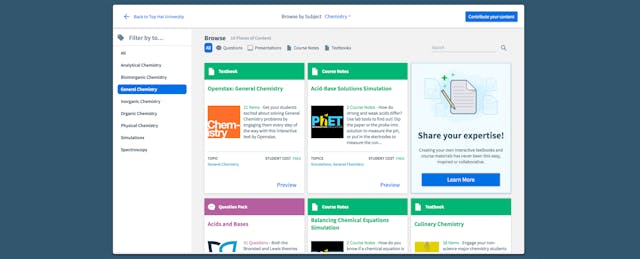As a medium, print is incompatible with the blistering pace of change and new discoveries. Textbooks are outdated as soon as they go to press. So why should students fork out hundreds of dollars for them?
That’s the question Top Hat has been hearing from college students and faculty, and why the Toronto company has decided to take on the publishing business. Today it announced the public launch of its digital textbook marketplace, along with a funding boost of $7.5 million from Leaders Fund. The latest cash infusion is an extension of the company’s $22.5 million Series C round, announced this past February. In total, Top Hat has raised just shy of $50 million.
Throwing its, er, hat into the publishing business marks a big step for the company, which launched in 2009 with a web and mobile classroom response tool to compete with physical hand-held clickers. It later added features that let professors create and distribute homework assignments.
Citing AirBnB and Uber as the usual model of successful “peer-to-peer marketplaces,” Top Hat CEO Mike Silagadze says his team aims to help any professor author, collaborate, share, sell and use digital courseware. Faculty members who have Top Hat accounts can now browse through 20 subjects’ worth of digital “coursepacks” on the Top Hat Marketplace, which include interactive textbooks, course notes, simulations, presentations and questions.
More than 90 percent of the 600 pieces of digital content currently in the marketplace are available for free. There are also offerings from openly-licensed content providers such as OpenStax, Saylor and PhET.
The company quietly launched the marketplace to a private group of users in fall 2016. Today, any professor with a Top Hat account can create coursepacks using an authoring platform that supports text, images, videos and interactive content such as live Twitter feeds and maps. The company runs each submission through iThenticate, a service operated by Turnitin, to ensure that professors do not run afoul of copyright issues.
Authors who sell their content on the marketplace will get roughly 50 percent of each sale. (Or they can opt to make the content free.) They can also update their digital textbooks at any time. When this happens, existing users and purchasers of that content can choose to accept or reject these changes.
By allowing authors to update content instantaneously, Top Hat aims to upend the costly tradition of publishers issuing a new edition on a periodic basis. This can take up to three years, and sometimes result in an even pricier textbook. This business befuddles Silagadze, who proclaims that “I want to take the $10 billion publishing industry in higher education and turn it into a $2 billion industry.” (In doing so, of course, he hopes Top Hat will capture most of that latter figure.)
For professors who want to take matters into their own hands, Top Hat’s publishing platform offers an “attractive” alternative, says Greg Domski, a chemistry professor at Augustana College, in Rock Island, Ill. who has co-authored two textbooks using the company’s authoring tools. As he was writing one of them, he recalls, scientists discovered four new elements that were added to the periodic table. So he quickly updated the chemistry textbook he was co-authoring.
“A lot of faculty are price-conscious and don’t want to burden their students with unnecessary textbooks,” Domski tells EdSurge. “If we can create content ourselves and get it to students inexpensively, that’s an attractive option.”
A new textbook today can cost students up to $400 (and a used version can command $300). By contrast, the highest-priced coursepack in the Top Hat marketplace currently costs $80. There’s an important caveat, though: these materials are only available (for purchase or for free) to students who have an existing Top Hat subscription, which currently cost $26 for one term, $38 annually or $75 for lifetime access.
Over the years, Top Hat has cemented its footprint across North America. The company claims users in 750 of the 1,000 largest higher-ed institutions in this region. Major adopters include the University of Wisconsin-Madison and Ohio State University, where the university makes Top Hat available to students for the majority of its courses.
Publishers are not watching idly. Cengage reported growing revenues from its digital MindTap series in its most recent investor presentation. McGraw-Hill also increased sales of its ALEKS, Connect and LearnSmart offerings. Macmillan has even reached out to Domski with an offer to review one of its digital chemistry textbooks.
“I suspect that large textbook companies, instead of trying to keep students to stick with print, are wisening up to the digital age,” says Domski.
Startups raise money to spend it, and Top Hat is growing at a blistering pace. There are already 250 employees, but Silagadze says his team is hiring 10 to 20 people a week across engineering, sales, and marketing roles.
The company was cashflow-positive last year, he adds. That’s a significant milestone for most venture-backed startups, but Silagadze and his investors are dipping back into the red in hopes of capturing bigger revenue and returns from competing with publishers.


